China issues white paper on CPC policies on governance of Xizang in new era
Updated: 2023-11-10 (Xinhua)  Print
Print 


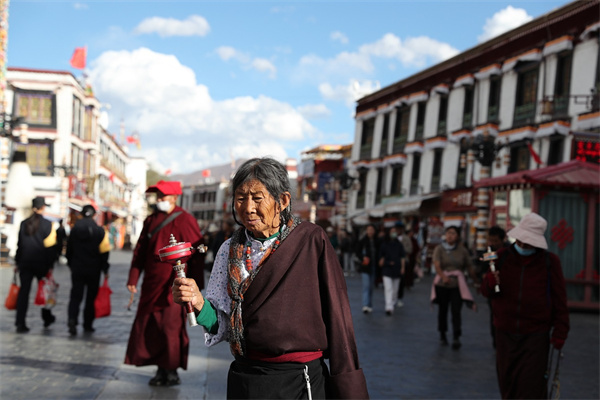
Tibetan pilgrims practice religious activities in front of the Jokhang Temple on the Barkor Street in Lhasa, capital of the Xizang autonomous region. [Photo by Wang Jing/chinadaily.com.cn]
BEIJING -- China's State Council Information Office on Friday released a white paper on the policies of the Communist Party of China on the governance of Xizang autonomous region in the new era.
The white paper, titled "CPC Policies on the Governance of Xizang in the New Era: Approach and Achievements," highlighted that the CPC's guidelines for governing Xizang in the new era have brought about all-round progress and historic success in various undertakings in the region.
5G networks cover all counties, main townships in Xizang
The 5G networks now cover all counties and main townships in Southwest China's Xizang autonomous region.
A total of 8,099 5G base stations and nearly 312,600 km of fiber-optic cables have been built in Xizang.
Optical fiber broadband, 4G, radio and TV signals cover almost all administrative villages in the region. Modern cloud and network integration has enabled local people to connect with the world online.
Xizang earmarks over 325m yuan for intangible cultural heritage protection
The central government and the local government of Southwest China's Xizang autonomous region had earmarked over 325 million yuan (about $45.26 million) between 2012 and 2022 for protecting intangible cultural heritage items.
Xizang has 106 ICH items on the national representative list with 96 bearers, and 460 items on the regional list with 522 bearers. Three items -- Gesar, Tibetan Opera, and the Lum medicinal bathing of Sowa Rigpa of Xizang -- have been registered on the Representative List of the Intangible Cultural Heritage of Humanity.
Xizang GDP grows by 128% from 2012 to 2022
The 2022 GDP of Xizang reached 213.26 billion yuan (about $29.7 billion), 2.28 times of that in 2012 calculated at constant prices.
The increase represented an average annual growth rate of 8.6 percent, which ranked among the highest in China.
Xizang fully guarantees freedom of religious belief
The Xizang autonomous region fully guarantees the freedom of religious belief and religious activities are carried out in an orderly manner.
The region today hosts over 1,700 sites for Tibetan Buddhism activities with approximately 46,000 Buddhist monks and nuns, four mosques with about 12,000 native Muslims, and one Catholic church with over 700 believers.
Over 1,700 religious and folk activities, including the Shoton Festival, Butter Lamp Festival, Saga Dawa Festival and the walks around lakes and mountains, help to preserve the solemn traditional rituals and demonstrate new vitality with modern cultural elements.
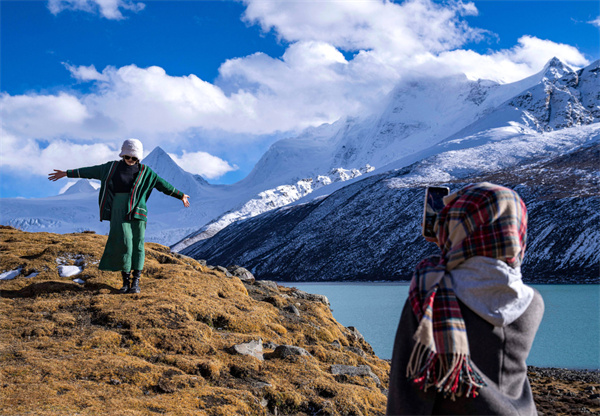
Xizang received 49.67 million domestic and overseas visitors in the first three quarters of this year, up 67.4 percent year on year. [Photo/Xinhua]
Average life expectancy reaches 72.19 years in Xizang
Average life expectancy in the Xizang autonomous region has increased to 72.19 years.
Air quality in Xizang remains excellent or good
Since 2016, the proportion of days with excellent or good air quality in Xizang has reached over 99 percent each year.
The air quality in main towns and cities has, on the whole, remained excellent or good, and the concentrations of six pollutants in seven prefecture-level administrative units has reached the state Grade-II standards or above. The air quality in the Mount Qomolangma area continues to be rated as excellent or good, reaching the state Grade-I standards.
In 2022, Lhasa ranked first among the 168 key cities in China in terms of air quality, and Nyingchi and Qamdo both enjoyed excellent air quality all year round.
Per-capita income of people lifted out of poverty grows fast in Xizang
The per-capita income of those lifted out of poverty in Xizang reached 13,800 yuan (about $1,922) in 2022, growing faster than the region's per-capita disposal income of rural residents.
Those people lifted out of poverty in Xizang have reliable access to food, clothing, housing, education and medical care, more harmonious living and working conditions, more convenient infrastructure and basic public services, and a proper social security system.
By the end of 2019, through the basic strategy of targeted poverty alleviation, the autonomous region had lifted 628,000 registered poor residents and 74 counties out of poverty. This represented victory in the battle against extreme poverty that had plagued Xizang for thousands of years.
Xizang sees rapid rise in per-capita disposable income of residents
Xizang has seen a rapid rise in the per-capita disposable income of residents.
The per-capita disposable income of the region's urban and rural residents as a whole rose to 26,675 yuan (about $3,715) in 2022 from 8,568 yuan in 2012, representing the country's highest growth rate for eight consecutive years since 2015.
The income ratio between urban and rural residents dropped from 3.22 in 2012 to 2.67 in 2022, narrowing the income gap.
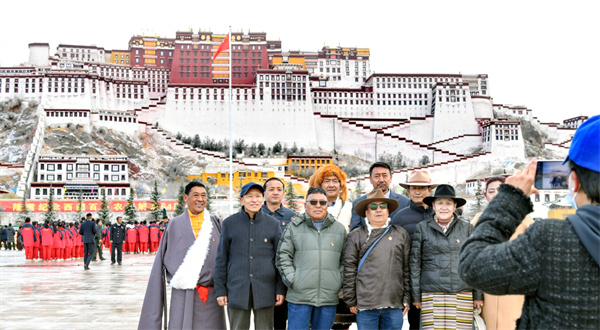
People take a group photo after a flag-raising ceremony at Potala Palace Square in Lhasa, Xizang autonomous region, March 28, 2023. CHINA DAILY
Xizang railway length nearly doubles in a decade
The total operating length of the railway network in Xizang was extended from 701 km in 2012 to 1,359 km in 2022.
The Fuxing high-speed train series is now operating in Xizang and reaches the regional capital of Lhasa.
Xizang establishes eco-environmental conservation, compensation mechanism
An eco-environmental conservation and compensation mechanism has been put in place in Xizang that covers forest, wetland, grassland, and water ecosystems.
Historical, cultural heritage in Xizang under effective protection
A total of 4,468 sites of historical or cultural interest of all types have been examined, registered and protected by the local county or district government. The region has 2,373 cultural relics protection units under the protection of governments at different levels, 70 of which are key units under state protection. Since 2013, over 100,000 precious cultural relics of all kinds have been carefully protected through digital archiving.
Study, use of Tibetan language, script guaranteed by law
The study and use of the Tibetan language and script are guaranteed by law, and the Tibetan language is widely used in fields such as health, postal services, communications, transport, finance, and science and technology.
Both standard Chinese and the Tibetan language can be found on public facilities, signage and advertisements. Radio and television programs in both languages are available at any time. Courses in both languages are taught in primary and secondary schools. By the end of 2022, Xizang had 17 periodicals and 11 newspapers in the Tibetan language, and had published 45.01 million copies of 7,959 Tibetan-language books.
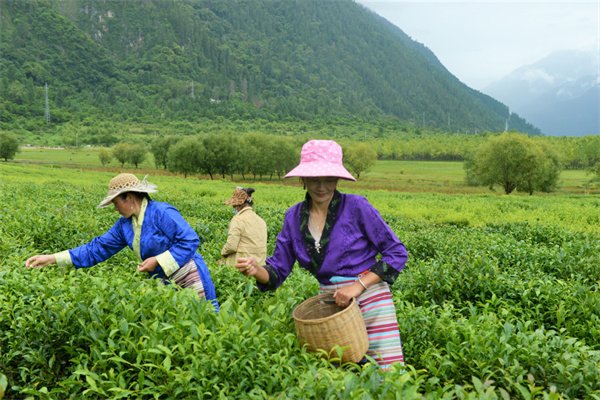
Workers pick the tea at Yigong tea plantation, in Yigong, Nyingchi in Southwest China's Xizang autonomous region, on July 29, 2021. [Photo by Zhao Shiyue/chinadaily.com.cn]
Fight against infiltration, subversion and secession continues in Xizang
In accordance with the general requirements of safeguarding national security and the region's specific circumstances, and upholding the rule of law in the governance of the region, Xizang adopts a proactive approach to combat secessionism.
The reactionary nature of the Dalai Group has been exposed and denounced, and the regional government relies closely on the people of all ethnicities to resist all forms of secession and sabotage.
Xizang sees sound development of cultural industry
The cultural industry of Xizang is prosperous and dynamic, and key cultural programs have been launched.
By the end of 2022, more than 8,000 cultural enterprises had registered in Xizang, employing over 70,000 people, and the added value of cultural and related industries reached 6.33 billion yuan (about $881.62 million).
During the 13th Five-year Plan period (2016-2020), 91 key cultural projects were successfully implemented, with a total investment of nearly 50 billion yuan.
Reincarnation of living Buddhas a practice recognized, respected
Reincarnation of living Buddhas is a practice recognized and respected by the government at all levels.
In 2007, the State-Issued Measures on the Management of the Reincarnation of Living Buddhas of Tibetan Buddhism stipulated the principles that should be followed, the conditions that should be met, and the application and approval procedures that should be implemented.
It also specified that reincarnated Tibetan living Buddhas, including Dalai Lamas and Panchen Rinpoches, must be looked for within the country, decided through the practice of lot-drawing from the golden urn, and receive approval from the central government.
Tibetan Buddhist activities conducted in orderly manner
Xizang conducts Tibetan Buddhist activities in an orderly manner and law-based management of religious affairs has made steady progress.
Fully implementing the Party's basic policy on religious affairs, Xizang has guided Tibetan Buddhism in adapting to socialist society, and moved faster to improve the institutions and standards for managing religious affairs in accordance with the law.
Measures of the Xizang Autonomous Region on Implementing the Regulations on Religious Affairs, Measures of the Xizang Autonomous Region on the Management of Major Religious Activities and Detailed Rules for the Implementation of the Measures on the Management of Living Buddha Reincarnation of Tibetan Buddhism have been issued and implemented to safeguard the legal rights and interests and order of religious society, properly resolve religion-related differences and disputes, improve monastery management, and promote religious harmony.
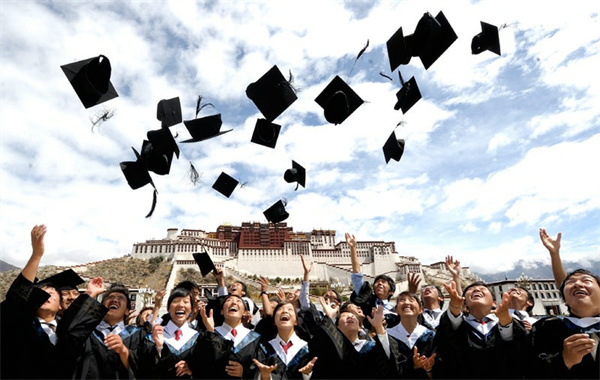
File photo shows the medical graduates of the Tibet University throwing mortarboards into the air. [Photo/Xinhua]
Rights of all people of all ethnic groups in Xizang guaranteed
Fresh progress has been made in strengthening the political development in Xizang, ensuring the rights of all people of all ethnic groups to be masters of the region and the country.
Educational undertakings achieve high-quality development
A modern education system encompassing preschools, primary and secondary schools, vocational and technical schools, institutions of higher learning, and continuing and special education institutions is in place.
The results of the seventh national census showed that the number of college or university graduates per 100,000 inhabitants in Xizang had risen from 5,507 in 2010 to 11,019 in 2020, while new entries into the region's workforce now have an average of 13.1 years of education.
Number of Tibetan antelopes increases to over 300,000
According to the second national survey on terrestrial animals and plants of China, the number of Tibetan antelopes increased from over 70,000 in the 1990s to over 300,000.
Clean energy makes up nearly 90% of installed power generation capacity in Xizang
Xizang has accelerated the building of a national clean energy base, and clean energy now makes up nearly 90 percent of the installed power generation capacity.
It has thus contributed to China's targets for peak carbon emissions and carbon neutrality.
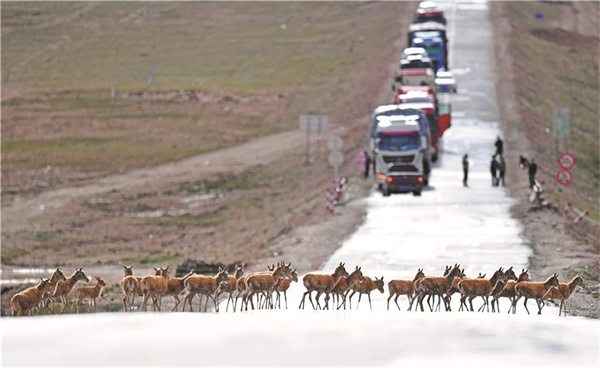
Tibetan antelopes cross the Qinghai-Tibet Highway in a leisurely fashion and head toward the Sanjiangyuan area in Northwest China's Qinghai province, in July 2023. ZHANG HONGXIANG/XINHUA
Xizang has 47 nature reserves of different types
Xizang boasts 47 nature reserves of different types at all levels, which cover a total area of 412,200 square kilometers.
Great progress registered in scientific surveys, technological breakthroughs on Qinghai-Tibet Plateau
Great progress has been registered in scientific surveys and technological breakthroughs on the Qinghai-Tibet Plateau.
The central government has launched the second comprehensive scientific survey on water, the eco-environment, and human activities on the Qinghai-Tibet Plateau, and conducted a thorough analysis of local environmental changes and their mechanisms.
This has generated a number of original theories in international frontier fields of geoscience and life sciences and substantially increased knowledge about the plateau.
Xizang continues to improve eco-environmental governance system
A series of policies, regulations and statutes have been promulgated and implemented, including the Plan on Eco-environmental Protection and Sustainable Development on the Qinghai-Tibet Plateau, the Law of the People's Republic of China on Ecological Conservation on the Qinghai-Tibet Plateau, and Regulations on Developing National Eco-civilization Model in the Xizang Autonomous Region.
Xizang follows a holistic approach to the integrated conservation and systematic management of mountains, rivers, forests, farmlands, lakes, grasslands, deserts and glaciers. A responsibility system has been introduced by which the responsibility for protecting rivers, lakes, forests and grasslands is assigned to specific persons with the title of chiefs.
Xizang experiencing period of unprecedented development
Since the 18th Communist Party of China National Congress, Xizang has experienced a period of unprecedented development and huge change, bringing more tangible benefits to the people.
The social and economic progress of Xizang epitomizes the nation's outstanding achievements in development, created on the roof of the world through the Chinese path to modernization.
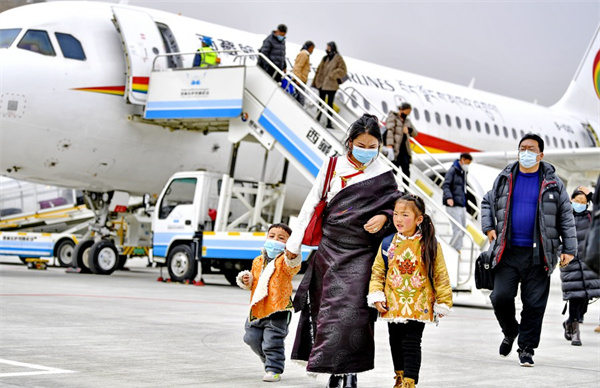
Passengers get off the Tibet Airlines flight TV9850 at Gonggar Airport in Lhasa, Southwest China's Xizang autonomous region, Dec 30, 2021. [Photo/Xinhua]
Xizang maintains sustainable, sound and rapid economic development
Xizang has maintained sustainable, sound and rapid economic development. The economy of Xizang has witnessed solid and steady growth.
Nearly 90% deputies to people's congresses in Xizang from ethnic groups
A total of 89.2 percent of the 42,153 deputies to people's congresses at four levels in Xizang are from the Tibetan or other ethnic minorities.
The offices of chairperson or vice chairpersons of the Standing Committee of the People's Congress of Xizang Autonomous Region are occupied by Tibetans, as is the office of the governor of Xizang.
Xizang continues to prioritize eco-environmental conservation
In its efforts to become a national or even an international model in advancing eco-civilization, Xizang continues to prioritize eco-environmental conservation, follows a holistic approach to coordinating conservation and development, and pursues green and sustainable development.
Protecting the natural environment in Xizang will benefit the country and the people for thousands of years to come.
It will continue to deliver eco-environmental dividends while building a beautiful Xizang.








